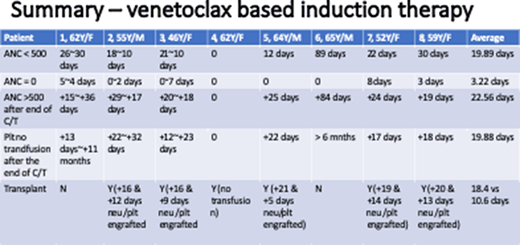Background: The present standard induction treatment for newly diagnosed acute myeloid leukemia (ND AML) is three days' daunorubicin or idarubicin plus seven days' cytarabine chemotherapy (3+7). Venetoclax plus azacytidine or low dose cytarabine is effective and better than azacitidine or low dose cytarabine alone for ND AML in VIALE A and VIALE C trials, respectively and the outcome by Venetoclax dose levels was not different between 400 mg, 800 mg, or 1200 mg a day. As a strong CYP3A inhibitor, posaconazole can increase serum level of Venetoclax and the dosage could be reduced to 75~100mg a day.
Method: We treat ND AML patients with uninterrupted Venetoclax 100 mg plus posaconazole 300 mg daily and 7 days' standard dose of cytarabine (100 mg/m2/day) or 7 days' azacitidine (75 mg/m2/d), followed by 5 days' consolidation cytarabine (100 mg/m2/d) or another 7 days' azacitidine, and then followed by allogeneic hematopoietic stem cell transplantation.
Results: Eight patients have enrolled the treatment including 7 underwent venetoclax/posaconazole/cytarabine and one venetoclax/posaconazole/azacitidine patients and four patients are secondary AML (one myeloma, one MDS, and 2 breast cancer patients). All patients were hematologic complete remission achieved in one month and 6 patients underwent allogeneic hematopoietic stem cell transplantation including one from matched sibling, two from matched unrelated, and three from haplo-identical donors (sons). Febrile neutropenia rates were similar to 3+7 treatment patients on historical comparison but shorter period of febrile illness. There was no grade II or higher adverse effect of oral mucosa and gastrointestinal tract as compared with conventional 3+7 therapy. Two out of six allo-transplant patients got leukemia relapse then salvage treatment ensued and the other 2 non-transplant and 4 allo-transplant patients are persisted in complete remission.
Conclusion: Venetoclax plus posaconazole and standard dose cytarabine is a feasible choice of induction therapy in ND AML and high CR rate and transplant rate achieved and there was no detrimental effect upon the hematopoietic recovery during induction and transplant therapy.
No relevant conflicts of interest to declare.
Author notes
Asterisk with author names denotes non-ASH members.


This feature is available to Subscribers Only
Sign In or Create an Account Close Modal